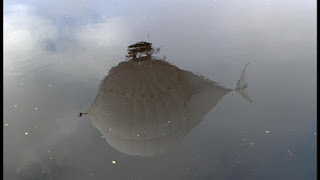Category: Werner Herzog / In category: 6 of 10 / Overall 70 of 100
 ‘The White Diamond’ opens with a potted history of aviation, before settling into the story of Graham Dorrington, an aeronautical designer who –
‘The White Diamond’ opens with a potted history of aviation, before settling into the story of Graham Dorrington, an aeronautical designer who –No, scratch that. Potted history of aviation, my ass! This is a Werner Herzog film. ‘The White Diamond’ opens with a skilful collage of archive footage depicting mankind’s earliest attempts to get off the ground, often ending in disaster, with Herzog calling time on his oblique history lesson at the point where “the real future of aviation was thought to be the airship. Like the roads now filled with automobiles, the skies would be full of airships.”
This opening section fades out with images of the Hindenburg descending in a coruscation of flames. And on this sobering note, the film settles into the story of Graham Dorrington, an aeronautical designer who pioneers a sort of mini-airship for use in scientific research above the jungle canopies of Guyana.
 At first, Dorrington seems an atypical Herzog protagonist. There’s a boyish enthusiasm in his to-camera discussions of the work he’s involved in; he’s passionate but never obsessive. He comes across as too good-natured to embody the kind of crazed jungle-bound undertakings that Herzog portrays elsewhere in his filmography. Put it this way: if ‘The White Diamond’ were a feature and not a documentary, Dorrington would be played not by Klaus Kinski but Stephen Fry.
At first, Dorrington seems an atypical Herzog protagonist. There’s a boyish enthusiasm in his to-camera discussions of the work he’s involved in; he’s passionate but never obsessive. He comes across as too good-natured to embody the kind of crazed jungle-bound undertakings that Herzog portrays elsewhere in his filmography. Put it this way: if ‘The White Diamond’ were a feature and not a documentary, Dorrington would be played not by Klaus Kinski but Stephen Fry.Gradually, though, Herzog works his way towards the tragic and defining event of Dorrington’s career; the event that still haunts him, that throws its shadow across a decade of his life and over the current project.
 In 1993, testing a prototype of Dorrington’s mini-airship, the internationally renowned wildlife photographer Dieter Plage flew above the Sumatran rainforests. His camera became entangled in the canopy and, while trying to retrieve it, Plage fell from the airship. The fall killed him. When Dorrington eventually discusses the event, and the “heaviness” he feels over Plage’s loss, Herzog captures the moment sensitively; his camera is never a voyeur.
In 1993, testing a prototype of Dorrington’s mini-airship, the internationally renowned wildlife photographer Dieter Plage flew above the Sumatran rainforests. His camera became entangled in the canopy and, while trying to retrieve it, Plage fell from the airship. The fall killed him. When Dorrington eventually discusses the event, and the “heaviness” he feels over Plage’s loss, Herzog captures the moment sensitively; his camera is never a voyeur.Plage’s death makes Dorrington trepidacious when it comes to the maiden voyage of his new airship, not least because he has two candidates eager to test it out and never mind the potential dangers. One – of course – is Herzog himself. The other is Marc Anthony Yhap, one of the indigenous populace who congregate to assist and/or observe. Herzog finds in Yhap the soul of a fellow poet. (The title comes from Yhap’s description of the airship.) The eminently laconic Yhap waxes lyrical about taking off in the airship, drifting slowly and peacefully all the way to Europe to be reunited with his family.
 If the kinship between Herzog and Yhap is tangible, the slowly developing friendship between Dorrington and Yhap is poignant and forms the human centre of the film. The final scenes, bathed in the ecstatic truth that Herzog ceaselessly strives for, has Dorrington take Yhap up in the airship. The indigent’s delight is, if not an exorcism of sorts, then certainly a counterbalance to the weight Dorrington has been carrying around since Plage’s terrible accident.
If the kinship between Herzog and Yhap is tangible, the slowly developing friendship between Dorrington and Yhap is poignant and forms the human centre of the film. The final scenes, bathed in the ecstatic truth that Herzog ceaselessly strives for, has Dorrington take Yhap up in the airship. The indigent’s delight is, if not an exorcism of sorts, then certainly a counterbalance to the weight Dorrington has been carrying around since Plage’s terrible accident.Another moment of ecstatic truth – approaching, in this case perhaps, a spiritual truth – comes when Herzog’s cameras, lowered painstakingly, penetrate a hitherto inaccessible cave behind the Kaieteur Falls which provides roosting for innumerable white-tipped swifts. Call it legend, call it superstition, but the locals believe that said cave is holy, that whatever is discovered in there should never be made public. Herzog, respectful of their beliefs, opts to keep the footage under wraps.
 “By dint of declaration the so-called Cinéma Vérité is devoid of vérité. It reaches a merely superficial truth, the truth of accountants,” Herzog wrote in his gauntlet-throwing Minnesota Declaration. “Filmmakers of Cinéma Vérité resemble tourists who take pictures amid ancient ruins of facts. Tourism is sin and travel on foot a virtue.” He’s absolutely right. And here he proves that the absence of the image can be just as revealing and ecstatically true.
“By dint of declaration the so-called Cinéma Vérité is devoid of vérité. It reaches a merely superficial truth, the truth of accountants,” Herzog wrote in his gauntlet-throwing Minnesota Declaration. “Filmmakers of Cinéma Vérité resemble tourists who take pictures amid ancient ruins of facts. Tourism is sin and travel on foot a virtue.” He’s absolutely right. And here he proves that the absence of the image can be just as revealing and ecstatically true.


Tidak ada komentar:
Posting Komentar